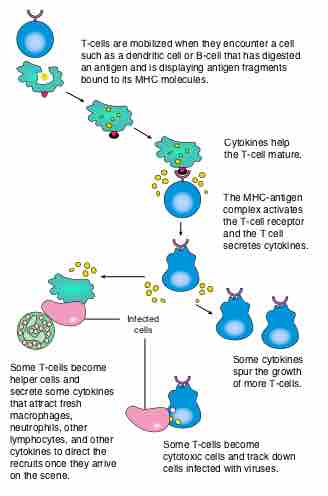Many different categories and subsets of T cells perform various roles for the immune system. Differentiation for most categories of T cells occurs during the the T cell maturation, but memory cell and helper T subset differentiation occurs after maturation following antigen presentation. The different categories of T cells are the basis for cell-mediated immune system activity.
Helper T Cells
Helper T cells assist other white blood cells in immunologic processes by facilitating cytokines that activate and direct other immune cells. Their primary functions include antigen presentation and activation of B cells, and activation of cytotoxic T cells and macrophages. These cells are also known as CD4+ T cells because they express the CD4 protein on their surfaces. Helper T cells become activated when presented with peptide antigens by MHC class II molecules, which are expressed on the surface of antigen-presenting cells. Once activated, they divide rapidly and secrete regulatory cytokines such as IFN-gamma and certain interleukins. These cells can differentiate into one of several subtypes, including TH1, TH2, TH3, TH17, or TFH, which secrete different cytokines to facilitate a different type of immune response. Differentiation into helper T cell subtypes occurs during clonal selection following T cell activation of naive T cells.
Cytotoxic T cells
Cytotoxic T cells (TC cells, or CTLs) destroy virus-infected cells and tumor cells, and cause much of the damage in in transplant rejection and autoimmune diseases. These cells are also known as CD8+ T cells since they express the CD8 glycoprotein at their surfaces. They recognize their targets by binding to antigens associated with MHC class I, which is present on the surface of nearly every cell of the body. Cytotoxic T cells recognize their antigen on pathogens through their T cell receptor, and kill the pathogen through degranulation and cell-mediated apoptosis. The cytotoxic enzymes and proteases travel to their target cells through a microtubule cytoskeleton. Through IL-10, adenosine and other anti-inflammatory cytokines secreted by regulatory T cells, the CD8+ cells can be inactivated to an anergic state, which can prevent or reduce the severity of autoimmune diseases.
Memory T Cells
Memory T cells are a subset of antigen-specific T cells that persist long after an infection has resolved. They rapidly proliferate to large numbers of effector T cells upon re-exposure to their antigens, thus providing the immune system with "memory" against past infections. The secondary immune response mediated by memory T cells is much faster and more effective at eliminating pathogens compared to the initial immune response. Memory T cells comprise two subtypes: central memory T cells (TCM cells) and effector memory T cells (TEM cells), which have different properties and release different cytokines. Effector memory cells may be either CD4+ or CD8+, and produce either helper or cytotoxic T cells in a secondary immune response.
Regulatory T Cells
Regulatory T cells (Treg cells), also known as suppressor T cells, are crucial for the maintenance of immunological tolerance. Their major role is to shut down T cell-mediated immunity toward the end of an immune reaction and suppress auto-reactive T cells that escaped the process of negative selection in the thymus. Most Treg cells are CD4+ and arise in the thymus. Naturally-occurring Treg cells can be distinguished from other T cells by the presence of an intracellular molecule called FoxP3. Mutations of the FOXP3 gene can prevent regulatory T cell development, causing the fatal autoimmune disease IPEX.
Natural Killer T Cells
Natural killer T cells (NKT cells – not to be confused with natural killer cells) bridge the adaptive immune system with the innate immune system. Unlike conventional T cells that recognize peptide antigens presented by major histocompatibility complex (MHC) molecules, NKT cells recognize glycolipid antigen presented by a molecule called CD1d. Once activated, these cells perform functions ascribed to both Th and Tc cells (i.e., cytokine production and release of cytolytic/cell killing molecules). They are also able to recognize and eliminate some tumor cells and cells infected with herpes viruses. They are among the least common type of T cell in the body and are found in the highest density in the liver. There is an association between NKT cell deficiency and development of autoimmune diseases and chronic inflammatory diseases like asthma, but the exact mechanism of this association is not fully understood.

T cell Activation
T cells become activated upon encountering a pathogen and can become either cytoxic T or helper T cells.